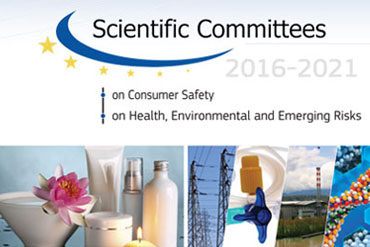- Send to a friend
-
-
facebook
-
google +
-
Print version
-
E-mail this page
Health-EU newsletter
176 -
Focus
New merger and new members – but the Scientific Committees' role remains the same
by Xavier Prats Monné, Director-General of DG Health and Food Safety, European Commission

A new generation of members of the European Commission's independent Scientific Committees was inaugurated at the end of April. I was pleased to be present at this occasion and to welcome the experts who will over the coming five years help the Commission make evidence-based policy decisions in the fields of health, environment and consumer safety. At a time when science-based decision making is often put at risk, I cannot stress enough what an important role the experts hidden behind the Committees' names have: it is them who do the work, engage in painstaking research, and ensure that conclusions are reviewed, checked and underpinned by evidence.
To improve efficiency and avoid overlap, this moment also marked a change in structure: the former Scientific Committee on Health and the Environment and theformerScientific Committee on Newly Identified and Emerging Health Risks have become one single Scientific Committee on Health, Environmental and Emerging Risks. The Scientific Committee on Consumer Safety remains the same as before in structure and purpose.
Over 350 scientists sent in their applications, which is a good indication of the Committees' reputation. It was not easy to narrow down the selection from such a talented group of candidates from around the world, but I am happy to see that the selected 34 members – 17 for each Committee – bring together an impressive range of expertise whilst representing a variety of nationalities, achieving gender balance, and reaching a good mix of reappointed and new members. Also, importantly, the members of the Committees must be free from prejudice and potential conflicts of interest, so they can advise the European Commission on scientifically complex and politically sensitive issues.
What will the Committees' members do? They will review and evaluate relevant scientific data to derive conclusions, assess potential risks and provide evidence-based advice. In this way they will help protect the health of EU citizens while supporting innovation, jobs and growth in the EU.
They will thus further contribute to the already impressive record of scientific opinions, for which we owe gratitude to previous years' experts – since their setup in 1978, the Scientific Committees have adopted more than a thousand opinions. Subjects recently handled include the potential risks of sunbeds, electromagnetic fields, tobacco additives, surgical mesh and metal-on-metal hip replacements, just to give an indication of the range of topics of relevance to EU citizens.
http://ec.europa.eu/dgs/health_food-safety/dyna/enews/enews.cfm?al_id=1685
The SCENIHR final Opinion on Additives used in tobacco products has been published
The European Commission and its independent Scientific Committee on Emerging and Newly Identified Health Risks (SCENIHR) published the SCENIHR final Opinion on Additives used in tobacco products on 29 January 2016. This is the first of two Opinions on this topic requested by the Commission to help with identifying additives that should be placed on the priority list foreseen in the Tobacco Products Directive.
The Tobacco Products Directive (2014/40/EU) , adopted in 2014, strengthens the rules on the manufacture, presentation and sale of tobacco and related products. Article 7 of the Directive foresees prohibiting tobacco products with particular types of additives, e.g. vitamins, caffeine or taurine, additives with colouring properties for emissions, and additives that facilitate inhalation or nicotine. In accordance with Article 6, the Commission had to develop and update a priority list of at least 15 additives contained in cigarettes and roll-your-own tobacco. This first scientific Opinion identifies the additives that should be put on the priority list.
, adopted in 2014, strengthens the rules on the manufacture, presentation and sale of tobacco and related products. Article 7 of the Directive foresees prohibiting tobacco products with particular types of additives, e.g. vitamins, caffeine or taurine, additives with colouring properties for emissions, and additives that facilitate inhalation or nicotine. In accordance with Article 6, the Commission had to develop and update a priority list of at least 15 additives contained in cigarettes and roll-your-own tobacco. This first scientific Opinion identifies the additives that should be put on the priority list.
In fact, the SCENIHR identified 48 single chemicals to be placed on the priority list. These compounds were selected because they have or are suspected to have one or more of the following properties:
- toxicity in unburned form (including carcinogenic, mutagenic or toxic for reproduction)
- facilitating inhalation or increasing nicotine uptake, which may contribute to addictiveness
- characterising flavour, one of the factors potentially contributing to attractiveness
- formation of any kind of toxic chemicals after combustion
The full list and details about how and why single compounds were selected for the priority list can be found in the Opinion, and an easy-to read fact-sheet on tobacco additives is also available in English, French, German and Spanish.
The second Opinion, to be published later this year, aims to help with the development of guidelines for types of studies and their criteria that should be requested by manufacturers to assess the relevance of the individual additives.
http://ec.europa.eu/health/scientific_committees/emerging/docs/scenihr_o_051.pdf (853 KB)
(853 KB)
The SCENIHR Preliminary Opinion on the Health Effects of Sunbeds has been published for public consultation
The European Commission and its independent Scientific Committee on Emerging and Newly Identified Health Risks' (SCENIHR) preliminary Opinion on the Biological effects of ultraviolet radiation relevant to health with particular reference to sunbeds for cosmetic purposes, for a public consultation open through 27 April 2016. A public hearing on the topic was held in Luxembourg on 12 April, 2016, with the participation of industry, NGOs, researchers, cancer experts and others. The preliminary Opinion looks at the rationale for and risks associated with the use of sunbeds.
Based on the available scientific evidence, the SCENIHR concludes that ultraviolet radiation (UVR) is a complete carcinogen, both an initiator, and a promoter. There is strong evidence that sunbed exposure causes skin melanoma, squamous cell carcinoma and, to a lesser extent, basal cell carcinoma, especially when exposure starts young.
There is also some evidence that sunbed exposure may cause ocular melanoma. Sunbed use is responsible for a noticeable proportion of both melanoma and non-melanoma skin cancers and for a large percentage of melanomas arising before the age of 30. The SCENIHR also concludes that sunbed exposure has little health benefits, and there is no need to use sunbeds for optimal Vitamin D levels. Because of evidence of the carcinogenic effects of sunbed exposure and of the nature of skin cancer induction (there are no indications for threshold levels of UV-irradiance and UV–dose), the SCENIHR concludes that there is no safe limit for UV irradiance from sunbeds.
The SCHEER (the new Committee replacing the SCENIHR) will finalise the Opinion later on this year after the assessment of relevant contributions received during public consultation.
http://ec.europa.eu/health/scientific_committees/emerging/docs/scenihr_o_052.pdf (773 KB)
(773 KB)
The SCHER final Opinion on potential risks to human health and the environment from the use of calcium cyanamide as fertiliser has been published
Calcium cyanamide, which comprises 44% calcium and 24% nitrogen, was first produced in the late 1800s for use as a fertiliser in the agriculture sector. In 2013, the Scientific Committee on Health and Environmental Risks (SCHER) was asked to assess the potential risks to human health and the environment from using this substance as a fertiliser.
The European Commission and the SCHER published the final Opinion on potential risks to human health and the environment from the use of calcium cyanamide as fertilizer on 22 April 2016.
The SCHER calculated human health risks using worker exposure models for the use of calcium cyanamide as fertiliser, based on approaches used for registration of plant protection products. Exposure calculations were made for scenarios where the substance would be used for both professional and private use. Calculations were also made for by-standers and residents, including children.
The SCHER concluded that harmful effects for humans and for the environment could not be excluded when calcium cyanamide is used at the current rates of application.
http://ec.europa.eu/health/scientific_committees/environmental_risks/docs/scher_o_169.pdf (2 MB)
(2 MB)
The SCHER Final Opinion on estimates of the amount of toy materials ingested by children has been published
The European Commission and its independent Scientific Committee on Health and Environmental Risks (SCHER) published their final Opinion on estimates of the amount of toy materials ingested by children on 15 April 2016.
The SCHER was asked to review available data on the ingestion of the following three types of toy material by children and to evaluate whether the ingestion amounts which formed the basis for the migration limits of 19 elements in the Toy Safety Directive are still appropriate or whether they should be changed (e.g. to weekly limits, rather than daily).
are still appropriate or whether they should be changed (e.g. to weekly limits, rather than daily).
- Dry, brittle, powder-like or pliable toy material (ingestion amount 100 mg/day)
- Liquid or sticky toy material (400 mg/day)
- Scraped-off toy material (8 mg/day)
In the final Opinion the SCHER considers the ingestion amounts mentioned above to be appropriate, and that these ingestion amounts should remain classified as daily amounts rather than weekly.
http://ec.europa.eu/health/scientific_committees/environmental_risks/docs/scher_o_170.pdf (503 KB)
(503 KB)








